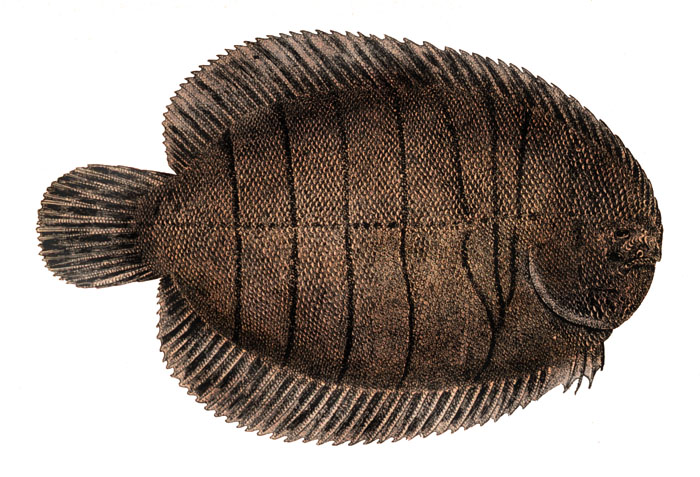Sole (fish) on:
[Wikipedia]
[Google]
[Amazon]

 Sole is a
Sole is a
Greenpeace International Seafood Red list
/ref>

 Sole is a
Sole is a fish
A fish (: fish or fishes) is an aquatic animal, aquatic, Anamniotes, anamniotic, gill-bearing vertebrate animal with swimming fish fin, fins and craniate, a hard skull, but lacking limb (anatomy), limbs with digit (anatomy), digits. Fish can ...
belonging to several families. Generally speaking, they are members of the family Soleidae, but, outside Europe, the name ''sole'' is also applied to various other similar flatfish, especially other members of the sole suborder Soleoidei as well as members of the flounder family. In European cookery, there are several species which may be considered ''true soles'', but the common or Dover sole '' Solea solea'', often simply called ''the sole'', is the most esteemed and most widely available.
Etymology of the word
The word ''sole'' in English, French, and Italian comes from its resemblance to a sandal, Latin . In other languages, it is named for the tongue, e.g. Greek (), German , Dutch or or the smaller and popular (young sole), Hungarian , Spanish , Cantonese (, 'dragon tongue'), Arabic () (for the common sole) meaning 'the tongue of ox' in Qosbawi accent, Turkish . A partial list of common names for species referred to as sole include: *In the ''sole'' suborder Soleoidei: ** The ''true sole
The true soles are a family, Soleidae, of flatfishes. It includes saltwater and brackish water species in the East Atlantic, Indian Ocean, West and Central Pacific Ocean, and the mediterranean sea. Freshwater species are found in Africa, souther ...
s'', Soleidae, including the common or Dover sole, ''Solea solea''. These are the only fishes called ''soles'' in Europe.
** The '' American soles'', Achiridae, sometimes classified among the Soleidae.
** The '' tonguefishes'' or ''tongue soles'', Cynoglossidae, whose common names usually include the word 'tongue'.
* Several species of righteye flounder in the family Pleuronectidae, including the lemon sole, the Pacific Dover sole, and the petrale sole.
Threats
The true sole, ''Solea solea'', is sufficiently distributed that it is not considered a threatenedspecies
A species () is often defined as the largest group of organisms in which any two individuals of the appropriate sexes or mating types can produce fertile offspring, typically by sexual reproduction. It is the basic unit of Taxonomy (biology), ...
; however, overfishing
Overfishing is the removal of a species of fish (i.e. fishing) from a body of water at a rate greater than that the species can replenish its population naturally (i.e. the overexploitation of the fishery's existing Fish stocks, fish stock), resu ...
in Europe has produced severely diminished populations, with declining catches in many regions. For example, the western English Channel
The English Channel, also known as the Channel, is an arm of the Atlantic Ocean that separates Southern England from northern France. It links to the southern part of the North Sea by the Strait of Dover at its northeastern end. It is the busi ...
and Irish Sea
The Irish Sea is a body of water that separates the islands of Ireland and Great Britain. It is linked to the Celtic Sea in the south by St George's Channel and to the Inner Seas off the West Coast of Scotland in the north by the North Ch ...
sole fisheries face potential collapse according to data in the UK Biodiversity Action Plan.
Sole, along with the other major bottom-feeding fish in the North Sea
The North Sea lies between Great Britain, Denmark, Norway, Germany, the Netherlands, Belgium, and France. A sea on the European continental shelf, it connects to the Atlantic Ocean through the English Channel in the south and the Norwegian Se ...
such as cod, monkfish, and plaice, is listed by the ICES as "outside safe biological limits." Moreover, they are growing less quickly now and are rarely older than six years, although they can reach forty. World stocks of large predatory fish and large ground fish such as sole and flounder were estimated in 2003 to be only about 10% of pre-industrial levels. According to the World Wildlife Fund in 2006, "of the nine sole stocks, seven are overfished with the status of the remaining two unknown."
In 2010, Greenpeace International has added the common sole to its seafood red list, as they are primarily caught by beam trawlers, which have a very high bycatch rate. The Greenpeace International seafood red list is a list of fish that are commonly sold in supermarkets
A supermarket is a self-service Retail#Types of outlets, shop offering a wide variety of food, Drink, beverages and Household goods, household products, organized into sections. Strictly speaking, a supermarket is larger and has a wider selecti ...
around the world, and which have a very high risk of being sourced from unsustainable fisheries./ref>
Notes
References
* Alan Davidson, ''North Atlantic Seafood'', 1979. . * Alan Davidson, ''Mediterranean Seafood'', 1972. .External links
* {{commercial fish topics Fish of Europe Commercial fish Fish common names